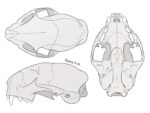Shape, integration, and morpho-functional trade-offs in the anterior cranium of cavioids in the context of caviomorph rodents
Alicia Álvarez, Marcos D. ErcoliCavioidea have a particularly diverging cranio-mandibular anatomy and are ecologically diversified. We analyzed the shape of the anterior cranium and the integration pattern of two modules of this region (rostrum and zygomatic arch-orbital partitions) in 96 caviomorph species to better understand the cavioid morphotype and which functional/ecological factors may explain its configuration. We detected a clear integration pattern between both modules in caviomorphs. Dependence on intense chewing but also on vision to detect predators could lead to the emergence of trade-offs between the orbits and masticatory muscles, and they are interpreted as main factors that could explain covariation patterns of caviomorphs. Cavioids set apart from other caviomorphs regarding the shape of both modules, being an extreme configuration mostly (but not always) characterized by a remarkable long rostrum, a long and dorso-ventrally compressed rostral masseteric fossa, elevated and wide orbits, an anteriorly tilted preorbital bar, and a low zygomatic arch. In caviine cavioids, these traits evolved without following the main integration trend represented in basal cavioids or most other caviomorphs clades. Other caviomorph taxa, such as erethizontids, are also set apart from the main trend. In cavioids, which are cursorial and diurnal rodents with a diet mainly based on grasses and fibrous dietary items, their particular morphological configuration is interpreted as possessing a modified rostral fossa to not affect vision. Caviines do not fit the general covariation trend of modular coupling of caviomorphs and basal cavioids, including representatives with particularly long or short rostrum, in relation to particular ecomorphological trends of each genus.
Forma, integración y compromisos morfofuncionales en el cráneo anterior de los cavioideos en el contexto de los roedores caviomorfos. Los cavioideos presentan una anatomía cráneo-mandibular particularmente divergente y son ecológicamente diversos. Aquí analizamos la forma del cráneo anterior y el patrón de integración de dos módulos de esta región (rostro y arco cigomático-órbita) en 96 especies de caviomorfos, para entender mejor el tipo cavioideo y cuáles factores funcionales/ecológicos podrían explicar su configuración. Detectamos un claro patrón de integración entre ambos módulos. La necesidad de una masticación intensa y, a su vez, de una visión adecuada para detectar depredadores podría generar compromisos entre las órbitas y los músculos masticatorios, y estos son interpretados como factores principales al explicar los patrones de covariación en caviomorfos. Los cavioideos se diferencian de otros caviomorfos en cuanto a la forma de ambos módulos, que representan una configuración extrema principalmente (aunque no siempre) caracterizada por un rostro destacablemente largo, una fosa masetérica rostral larga y dorsoventralmente comprimida, órbitas amplias y elevadas, una barra preorbitaria inclinada anteriormente y un arco cigomático bajo. En los cavioideos cavinos, estos rasgos evolucionaron sin seguir la tendencia principal de integración representada en cavioideos basales y muchos otros clados de caviomorfos. Otros taxones caviomorfos, como los eretizóntidos, también se destacan por diferenciarse de la tendencia principal. En los cavioideos, que son roedores cursoriales y diurnos con una dieta principalmente basada en pastos e ítems dietarios fibrosos, su configuración morfológica particular es interpretada como presentando una fosa rostral modificada para no interferir en la visión. Los cavinos no encajan en la tendencia de covariación general de acople entre módulos observada en otros caviomorfos y cavioideos basales, entre los que se incluyen representantes con rostros largos o cortos, en relación con tendencias ecomorfológicas particulares de cada género.

